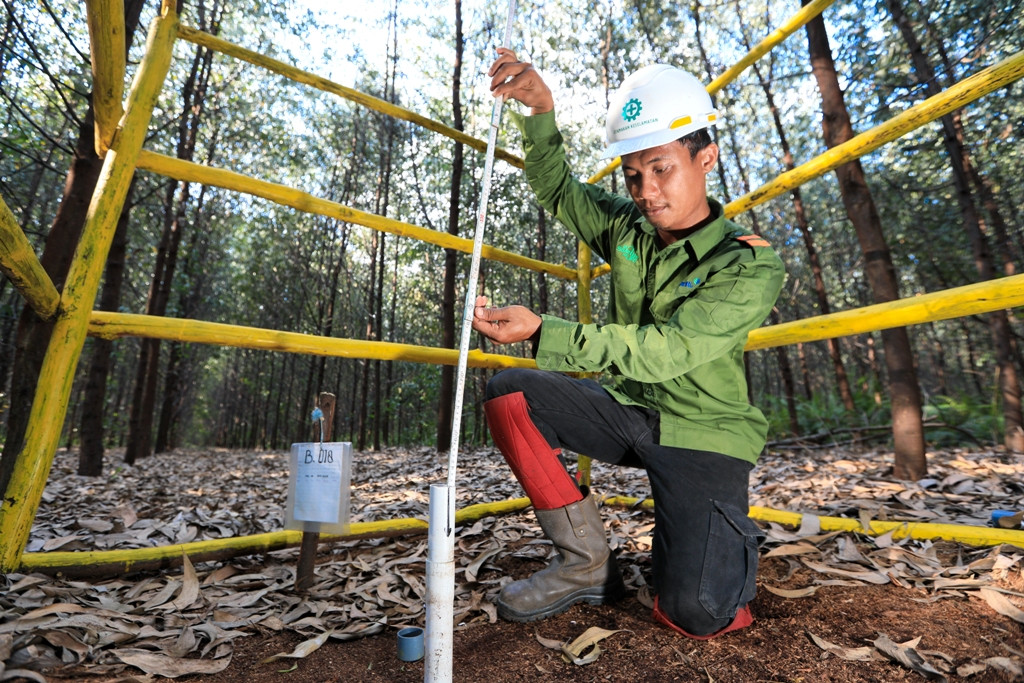New Research Into Temporal Dynamics of Tropical Peat Subsidence Published
Written by Dr Chandra S. Deshmukh, Greenhouse Gas Specialist, APRIL Peatland Science
Tropical peatlands, found in Southeast Asia and other tropical regions around the world, are unique landscapes whose protection and responsible management are crucial in combating climate change. Peatlands are susceptible to a natural process called subsidence, where the peat soil sinks as it compacts over time. This phenomenon is a result of the slow decomposition of organic material and the effects of gravity, leading to a gradual compression. While subsidence is a natural part of a functioning peatland ecosystem, it has become a growing concern due to the influence of human activities. Understanding the long-term trajectory and temporal dynamics of tropical peat subsidence can help guide the development of sustainable land use practices and mitigate environmental impacts.

A new study on subsidence on tropical peatlands published in the journal Geoderma in December 2022 sheds light on the long-term trajectory and temporal dynamics of tropical peat subsidence in relation to plantation management practices, particularly in large-scale plantations. The study was conducted by a team of scientists from Indonesia, the United Kingdom and Finland, and was led by Professor Chris Evans of the UK’s Centre for Ecology and Hydrology. This recent research, builds on an earlier study published in March 20192, and is based on one of the largest and longest-running subsidence monitoring datasets available for tropical peatlands worldwide.
The study aims to improve the understanding of the long-term subsidence rates and the effect of extreme climate events on overall subsidence rates in Acacia plantations and native forest landscapes. The authors analysed peat subsidence measurements from over 400 Acacia plantations and adjacent peat swamp forest plots, including a unique set of 62 sites which have been monitored since 2007 in Sumatra, Indonesia.
The results show that subsidence rates decrease over time, consistent with high-latitude peatlands3 and recent studies on tropical peatlands4,5. Subsidence rates decreased from 4.89 cm yr–1 in 2007 to 3.74 cm yr–1 in 2018 in the Acacia plantations. The decreasing subsidence rates over time suggest that the sustained constant subsidence rates6 may overestimate the long-term trajectory of peat subsidence and, thus, the associated susceptibility to flooding.
The measurements did not show a clear influence of distance from the nearest canal in the plantation on subsidence rates in the forest, consistent with previous findings2. They also do not show clear evidence of plantation impacts on groundwater level or subsidence beyond around 300 m from the nearest forest/plantation boundary.
The study also highlights the influence of climate change on peat subsidence. The subsidence rates increased substantially due to an extreme drought caused by a positive Indian Ocean Dipole phase combined with El Niño in 2015–16, resulting in deeper groundwater level. This raises the possibility that repeated extreme droughts in the region could lead to long-term degradation of peat swamp forest ecosystem7,8.
Given the low-lying nature of Southeast Asian peat landscapes, the magnitude of future subsidence rates will determine the susceptibility to flooding and economic sustainability of managed peatland landscapes. Resolving uncertainties in future subsidence rates for these economically important but vulnerable, carbon rich ecosystems requires continued and expanded subsidence monitoring, and a reliable understanding of the interacting effects of plantation management and intense and frequent extreme climate events on peatland function.
References:
- Erkens, G., van der Meulen, M.J. & Middelkoop, H. Double trouble: subsidence and CO2 respiration due to 1,000 years of Dutch coastal peatlands cultivation. Hydrogeol J 24, 551–568 (2016).
- Evans, C. D. et al. Rates and spatial variability of peat subsidence in Acacia plantation andforest landscapes in Sumatra, Indonesia. Geoderma 338, 410–421 (2019).
- Hutchinson, J.N. Record of peat wastage in the East-Anglian fenlands at Holme Post. Ecol 68, 229–249 (1980)
- Hoyt, A. M., Chaussard, E., Seppalainen, S. S. & Harvey, C. F. Widespread subsidence and carbon emissions across Southeast Asian peatlands. Geosci. 13, 435–440 (2020).
- Umarhadi, D. A. et al. Tropical peat subsidence rates are related to decadal LULC changes: insights from InSAR analysis. Total Environ. 816, 151561 (2022).
- Hooijer, A. et al. Subsidence and carbon loss in drained tropical peatlands. Biogeosciences 9, 1053–1071 (2012).
- Garcin, Y. et al. Hydroclimatic vulnerability of peat carbon in the central Congo Basin. Nature 612, 277–282 (2022).
- Dadap, N. C. et al. Climate change-induced peatland drying in Southeast Asia. Res. Lett. 17, 074026 (2022).




